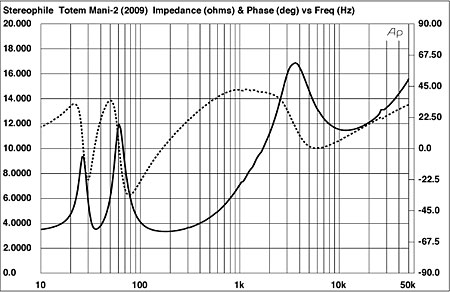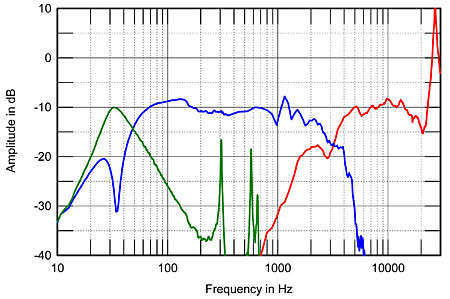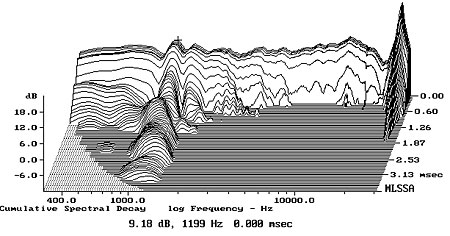| Columns Retired Columns & Blogs |
Totem Acoustic Mani-2 loudspeaker 2009 Measurements
Sidebar: Measurements
I performed my usual set of measurements using DRA Lab's MLSSA system. The 2009 sample of the Mani-2 offered an estimated sensitivity of 84.0dB(B)/2.83V/m, which is within experimental error of the 84.5dB I found eight years ago. Nevertheless, this is 3dB below average, implying that the Mani-2 needs to be used with an amplifier offering at least 50Wpc. Its impedance (fig.1) was very similar to that of the earlier samples and dropped to 3.5 ohms in the midbass and lower midrange, confirming that a good, 4 ohm–rated amplifier be used. The shape of the impedance curve suggested that with tube amplifiers, the Mani-2's balance will tilt up a little at high frequencies.

Fig.1 Totem Mani-2 Signature, electrical impedance and phase (2 ohms/vertical div.).

Fig.2 Totem Mani-2 Signature, acoustic crossover on tweeter axis at 50", corrected for microphone response, with nearfield responses of compound woofer (blue) and port (green), scaled in the ratio of their radiating diameters.
Fig.2 shows the individual responses on the tweeter axis of the tweeter (red trace), woofers (blue), and port (green). The tweeter's "oilcan" dome resonance results in the 20dB peak at 27kHz in this graph. While this resonance will not be fully excited with CD playback, due to the CD medium's having no energy above 22kHz, it will "sing" with high-sample-rate music, resulting in a possibly unpredictable effect on sound quality that will depend on the type of music played. The crossover to the compound woofers occurs at 3.2kHz, and as with the earlier samples of the Mani-2, there is some peakiness apparent at the top of the woofers' passband. The woofers are otherwise pretty flat, and their output extends to below 70Hz before plunging to the minimum-motion notch at the port-tuning frequency of 33Hz. The port's output peaks in the same region, and, as with both earlier samples, there are strong resonances at 305, 570, and 660Hz. These are of high enough Q not to be fully excited; in addition, the fact that the port faces away from the listener will reduce their audibility. But I still don't like to see them.

Fig.3 Totem Mani-2 Signature, anechoic response on tweeter axis at 50", averaged across 30° horizontal window and corrected for microphone response, with complex sum of nearfield woofer and port responses plotted below 300Hz: 1996 sample (green), 2001 sample (blue), 2009 sample (red).
The red trace above 320Hz in fig.3 shows the 2009 Mani-2's farfield response, averaged across a 30° horizontal angle on the tweeter axis, spliced at 320Hz to the complex sum of the woofer and port nearfield responses, taking into account both acoustic phase and the different distances of the radiators from a nominal farfield microphone position. The green trace shows the response of the 2001 sample, the blue trace the response of the 1996 sample, both taken under identical conditions (other than the fact that the 1996 measurement was performed in Santa Fe, New Mexico, at an altitude of 7000', and the 2001 and 2009 measurements were performed in Brooklyn at an altitude of 15'). Other than the 1996 sample having a slightly less-damped woofer alignment, the traces overlap beautifully—a tribute to Totem's ability to manufacture their speakers consistently.

Fig.4 Totem Mani-2 Signature, spatially averaged, 1/6-octave response in JA's listening room (red); spatially averaged, 1/6-octave response of PSB Imagine B (blue).
The blue trace in fig.4 shows the spatially averaged response at the listening position in my room of the PSB Imagine B I've been using as my current reference for reviews of small speakers. The red trace is the Mani-2's in-room response with the speakers in their original positions, before I moved them farther away from the sidewalls. The traces overlap closely between 100 and 400Hz, this being the region where room effects dominate. Above that region there's a little more energy in the Mani-2's upper midrange than in the PSB's, which is probably why the Totem sounded more forward overall, and the speakers are very similar in the treble, both being a bit brighter than is required for strict neutrality. But note the much more extended low-frequency output of the Totem compared with the PSB. With the low-frequency reinforcement offered by the room's sidewalls in these speaker positions, this relatively small speaker can deliver almost full extension down to 20Hz. As I said, I actually had to move the speakers farther out into the room to optimize the balance of midbass to upper bass.

Fig.5 Totem Mani-2 Signature, cumulative spectral-decay plot on tweeter axis at 50" (0.15ms risetime).
Finally, the Mani-2's cumulative spectral-decay plot (fig.5) is identical to that of the earlier versions, with a clean decay in the tweeter region, a huge peak at 27kHz associated with the tweeter dome's resonance, and still with some breakup apparent at the top of the woofer passband.—John Atkinson
- Log in or register to post comments




































